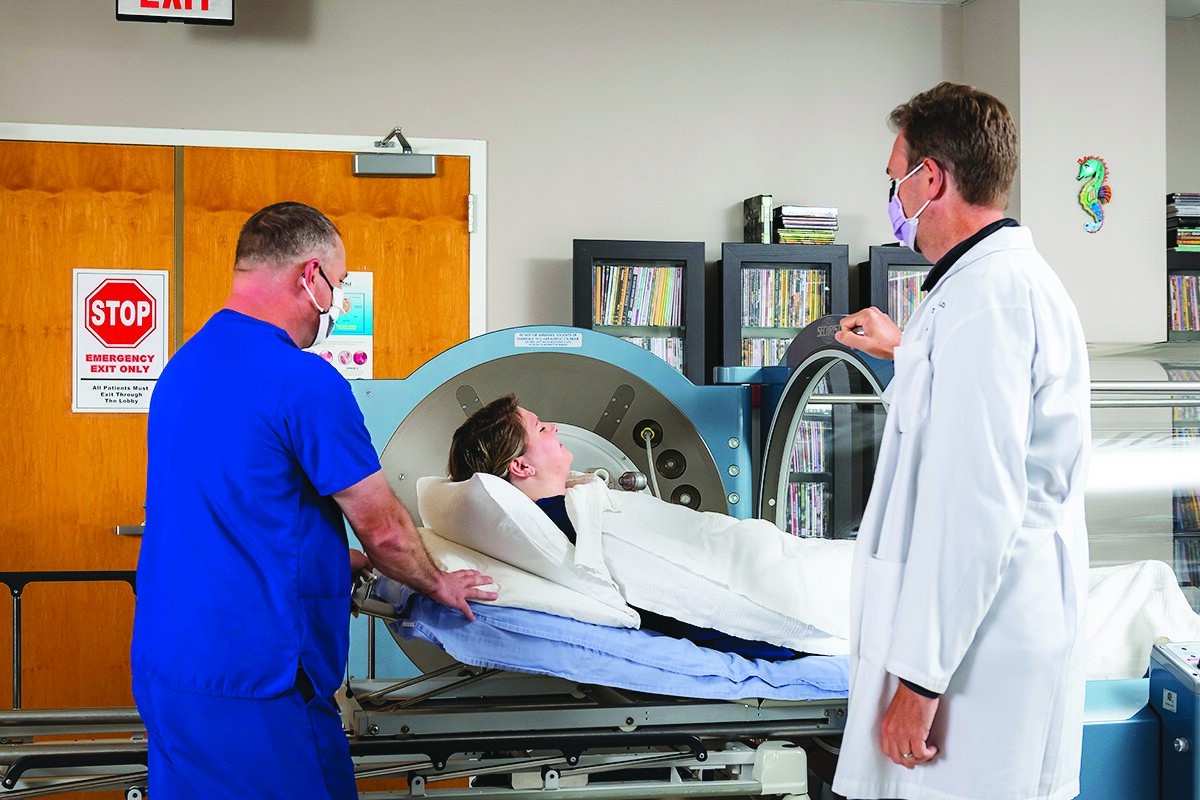When a breast reconstruction flap doesn’t heal the way it should, the hope and relief you were counting on can quickly turn into fear and uncertainty. In medical terms, flap failure happens when the tissue used in reconstruction doesn’t receive enough oxygen-rich blood flow or oxygen, leading to poor circulation or tissue death.
Breast reconstruction flaps are especially prone to complications such as compromised blood flow, delayed wound healing, and flap failure, especially in tissue with reduced perfusion due to prior radiation therapy. These failures not only threaten the surgical outcome but can also result in additional procedures, prolonged recovery time, and increased emotional stress. That’s where hyperbaric oxygen therapy (HBOT) comes in. By delivering 99% oxygen under pressure, HBOT can help rescue threatened flaps and improve the chance of graft survival.
Continue reading to explore how HBOT works, who is most likely to benefit, potential risks, and where to find the best hyperbaric oxygen therapy in Cumming, GA.
The Role of Hyperbaric Medicine After Breast Reconstruction
While HBOT is best known for treating conditions like carbon monoxide poisoning, it is increasingly being studied for its positive role in recovery from reconstructive surgery, with more than one clinical trial exploring its benefits for flap salvage.
After breast reconstruction surgery, some patients may face complications that threaten the survival of the tissue flaps. Certain risk factors, such as smoking, advanced age, or underlying conditions like peripheral artery disease, can weaken the circulatory system and increase the risk of poor healing. Women receiving free flaps or other types of flap procedures can face added risk from blood clots, ischemia, or delayed wound healing. A plastic surgeon may also see these complications in patients with prior radiation to the chest wall, delayed healing from open wounds, or weakened responses from the immune system.
How HBOT Works to Salvage Compromised Flaps and Grafts
Hyperbaric oxygen therapy gives struggling flaps and grafts the high-dose oxygen therapy they desperately need to survive. When a flap is compromised, the primary issue is typically that the tissue isn’t receiving sufficient blood flow or oxygen. This creates areas where cells are essentially suffocating and can’t heal on their own. Inside a hyperbaric chamber, patients breathe medical-grade oxygen at higher-than-normal pressure, which allows oxygen to dissolve directly into the bloodstream and reach tissues that are starved of oxygen.
This surge of oxygen not only keeps cells alive but also stimulates angiogenesis, the growth of new capillaries and blood vessels. allowing the tissue to establish a stronger, more lasting blood supply. HBOT also helps reduce swelling and inflammation, which protects tissue from tipping into necrosis, or permanent tissue death.
When to Start HBOT After Breast Reconstruction for Best Results
When it comes to saving compromised flap tissue, timing truly matters. The earlier oxygen reaches the struggling tissue, the more likely it is to survive; so starting hyperbaric oxygen therapy soon, if you’re having signs of poor blood flow, gives the best chance of healing. HBOT is typically delivered in a series of treatment sessions, and depending on the severity of the flap compromise, patients may require anywhere from six to 20 treatments to experience improvement.
To guide decisions along the way, surgeons sometimes use imaging tools like indocyanine green (ICG) angiography before and after HBOT sessions. This technology can help visualize blood flow in the flap, allowing the medical team to track progress and decide whether additional treatments are needed.
Signs That You May Need HBOT for Failing Flaps After Breast Reconstruction
Recognizing the early warning signs of a failing flap is key to getting help in time:
- If a flap is showing signs of vascular compromise, you might notice changes in skin color, such as areas turning dusky, pale, bluish, or dark instead of staying healthy pink.
- The tissue may also feel cooler to the touch compared to surrounding skin, or you might see slower healing, unexpected swelling, or small wounds that don’t close.
- In some cases, pain may actually increase instead of improve as you recover.
These changes often mean the flap isn’t receiving enough blood flow, putting it at risk of tissue loss. When these signs appear, early hyperbaric oxygen therapy intervention is an effective way to improve oxygen delivery, enhance tissue perfusion, and support healing before permanent damage sets in.
What to Expect During HBOT Treatment After Breast Reconstruction
During each HBOT session, you’ll lie comfortably inside a clear, pressurized chamber while breathing medical-grade oxygen. Most treatments last 60 to 90 minutes, and many patients use the time to rest, listen to an audiobook or music, nap, or watch TV. As the pressure builds in the chamber, you may experience a temporary fullness in your ears, similar to what occurs on an airplane. Your care team will guide you through simple techniques to alleviate the sensation. After treatment, you can return to your normal daily activities with no downtime required for recovery.
Discover the Best Hyperbaric Oxygen Therapy in Cumming for Failed Flaps and Grafts after Breast Reconstruction
When you’re deciding where to receive hyperbaric oxygen therapy, it’s important to feel confident in the clinic’s safety, expertise, and commitment to your care. At Regenerative & Hyperbaric Medicine, we bring decades of experience to every treatment, with a record of excellence that has earned us accreditation with distinction from the Undersea and Hyperbaric Medical Society (UHMS) since 2017.
Patients across Metro Atlanta and North Georgia count on us not only for our 100% safety record but also for our patient-first philosophy, where every HBOT plan is tailored to individual healing needs. With clinic locations in Cumming, Sandy Springs, and Marietta, our compassionate team delivers state-of-the-art care designed to shorten recovery times, reduce pain, and help patients return to their lives with confidence.
Ready to heal stronger and faster with help from the best hyperbaric oxygen therapy in Cumming?

.svg)





